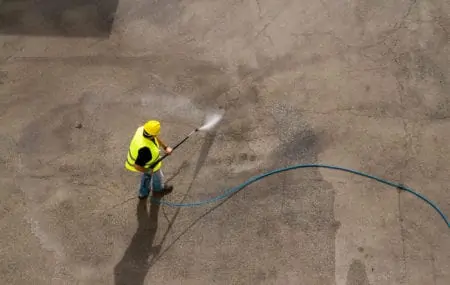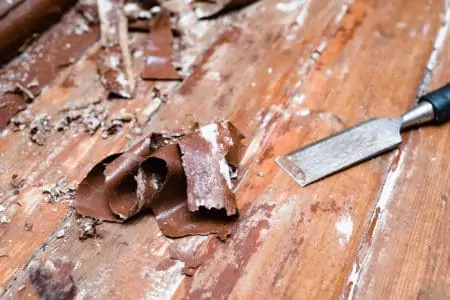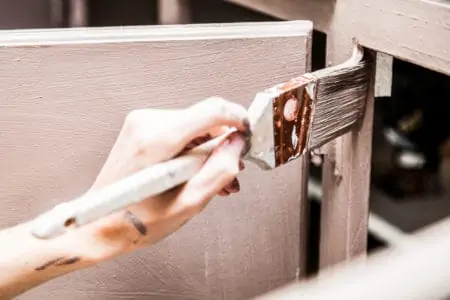Epoxy resin is fantastic stuff. It can transform your kitchen work surfaces, opening up a whole world of creative possibilities, but just how safe is this epoxy resin. We take it for granted that it is food-grade epoxy, but is it really?
This article examines safe epoxy resin and asks whether it is suitable for our food preparation areas.
Key Takeaways
- Epoxy resin can be food-safe when mixed and cured correctly, following the manufacturer’s instructions.
- Look for epoxy products without Bisphenol A (BPA) and carbolic acid, as they can be toxic and cause health issues.
- Food-safe epoxy should not release any taste or smell, have negligible amounts of non-crosslinked components, and not pose any health threats to humans.
- When working with epoxy, wear protective gloves, a respirator face mask, goggles, and ensure proper ventilation to minimize health risks.
Is Epoxy Resin Safe in Kitchens?
To answer this question, we first have to establish how it was mixed. Incorrectly mixed epoxy causes an imbalance in the chemical make-up, which might mean you’ve turned a safe product into a toxic one.
Also, if mixed correctly, and following the manufacturer’s instructions, you need to let it cure properly. If you don’t let it set fully, it could leach harmful substances.
Epoxy is a chemical compound consisting of carbon chains connected to other elements like hydrogen and oxygen. It gets its name from epoxide, meaning it is highly reactive with other chemicals.
Pure epoxy in a liquid state can cause skin irritations and chemical burns. A hardener is added to help the epoxy cure, which detoxifies it.
Epoxy also contains a few ingredients that many consider hazardous. Bisphenol A (BPA) and carbolic acid are extremely toxic and have been linked to cancers, health conditions, and respiratory problems.
While nothing is conclusive, and the Food and Drug Administration claims that you are at no higher level of risk from these chemicals, the jury is still out.
Food-Safe Epoxy – What Does That Mean?
There is no legal definition for food-safe epoxy; however, a broad answer would be it has to be epoxy that comes into contact with food without any adverse health implications.
So few epoxy resins are regulated under the Food and Drug Administration (FDA) that the ones who have paid the large sums of money to test their products to conform typically demand a higher price for their products.
In general, there are 3 definitions of food-safe epoxy as set out in the Title 21 Code of Federal Regulations: CFR 175, subsection 105 (Adhesives), and subsection 300 (Resinous and polymeric coatings):
- The material does not release any taste or smell that contaminates the food.
- Zero or negligible amounts of non-crosslinked components may be released into the food.
- There is no health threat to humans if they consume the food, and it hasn’t changed composition due to contact with the epoxy.
Why Are There Only a Few FDA Approved Epoxy Products?
The simple answer is cost. A few years ago, the EU set a standard definition across its member states, and companies were required to seal test their epoxy resin. This is expensive, so to many companies, it didn’t seem worth the added costs or effort to get tested for a food-safe classification for the American market.
However, a few manufacturers have taken the time and expense to get the food-safe accreditation, making their products more expensive.
What Epoxy Ingredients Are Potentially Dangerous?
When choosing a new epoxy for your kitchen, scan the label on the back of the packaging, and if you see any of these ingredients, it could mean that the epoxy is toxic to food.
Bisphenol A (BPA)
This is a core ingredient of many resins. It has been under scrutiny for many years as a toxic ingredient of many other products, including plastic bottles and other food packaging. While the case for banning this chemical grows in the media, the FDA and the European Food Safety Authority (EFSA) have yet to find any link to establish a health risk when exposed to typical levels.
Carbolic Acid
Carbolic acid is another main ingredient of epoxy resin. It is commonly used in agriculture as a weed killer, and sometimes you find it in disinfectants. Swallowing carbolic acid can lead to chemical burns and potential nerve and cell damage.
Epichlorohydrin
This ingredient is believed to be a cancer hazard and a danger to your kidneys and nerves. Other side effects include respiratory tract paralysis, delirium, eczema, and a host of different allergic reactions.
As our understanding of these ingredients and what they can do gets better, manufacturers are taking steps to substitute hazardous ingredients with organic matter and non-hazardous materials.
What Is the Best Food Safe Epoxy?
You can find food-grade products on the store shelves if you look hard enough. The issue is they are few and far between because so many manufacturers consider food-safe testing as expensive and unnecessary.
If you want an FDA-compliant brand, your best approach would be to look online. Read reviews, check their test seals, and pay close attention to their websites. However, you could save time and effort, and just refer to our food-safe choices.
ArtResin
While this is a resin for art projects, it is also useful to use on your kitchen countertops. It is certified FDA food-safe and contains zero BPA, no volatile organic compounds (VOCs), no harmful fumes, and it is non-flammable.
It comes as a 1-gallon kit comprising 0.5-gallon hardener and 0.5-gallon epoxy resin. It is also easy to use on a 1:1 mixing ratio, and 1-gallon covers 32 square feet.
ZDSticky Epoxy Resin
This resin is 100 percent food grade certified. It contains no VOCs, is low-odor, and is guaranteed not to smoke when mixed. This product is made from high-quality ingredients, formulated to a strict German safety code.
It has excellent UV protection and mixes on a 1:1 ratio to remove any errors; plus, it stays workable for 40 minutes and cures in 18 to 24 hours.
Art Coat
This Art Coat is food safe for incidental contact, meaning it is suitable for kitchen surfaces where food makes contact. It has zero VOCs, a 50 to 90-minute working time, and sets in 18 to 24 hours.
It mixes on a 1:1 ratio, again to remove any user errors, and this product is colorable, so you can choose what color you want for your kitchen countertops.
MAX CLR Epoxy Resin System
This MAC CLR is FDA approved for brief food contact, meaning that it shouldn’t touch for prolonged periods. It dries crystal clear and covers most surfaces, including wood.
It is impact-resistant and fully sanitizable, plus it cures in 6 hours. You get chemical resistance, and it prevents absorption.
Is Food Safe Epoxy Still the Same Quality?
Food safe epoxy is still the same quality as other epoxy resins; the difference is that you can use it on kitchen work surfaces where it comes into contact with food. Many of the toxic ingredients have been removed, and it has passed the strict FDA seal tests.
Important Safety Tips
When working with epoxy, some methods and techniques ensure you are safe, and the resin goes down as intended. Here are some top tips:
Avoid Skin Contact
Epoxy and hardeners contain toxic ingredients that could leave chemical burns and rashes if they make contact with your skin. Wearing protective gloves keeps your hands safe while mixing and spreading the resin.
Choose nitrile gloves instead of latex because they are medical-grade and can withstand chemical compounds.
Use a Respirator Face Mask
When the mixing begins, a chemical reaction takes place, which gives off toxic fumes. Wearing a respirator face mask with an A2 filter reduces the risk of poisonous vapors damaging your nasal passages and your throat.
Also, when the resin has set, and you are sanding and working the surface, keep the mask on because, while cured resin is non-toxic, the dust can still create a host of health issues if inhaled.
Protect Your Eyes
Wear goggles to avoid splashes making contact with your eyes. Also, the vapors that epoxy resin releases can cause your eyes to sting and water.
Keep Contact Brief
Even when the epoxy is FDA approved, it is recommended that contact with food is brief. It reduces the risk of contamination.
Good Ventilation
Keep windows and doors open when you mix the epoxy resin, as it could give off fumes that can quickly make you feel ill. If you can, work outside and carry the countertops into the house when they have cured.
Follow the Instructions
It sounds obvious to say it, but so many people skim through the instructions without heeding the warnings about misuse and incorrect mixing. The general rule of thumb when mixing epoxy is a 1:1 ratio. This removes the chances of human error and keeps the epoxy non-toxic when it cures.






